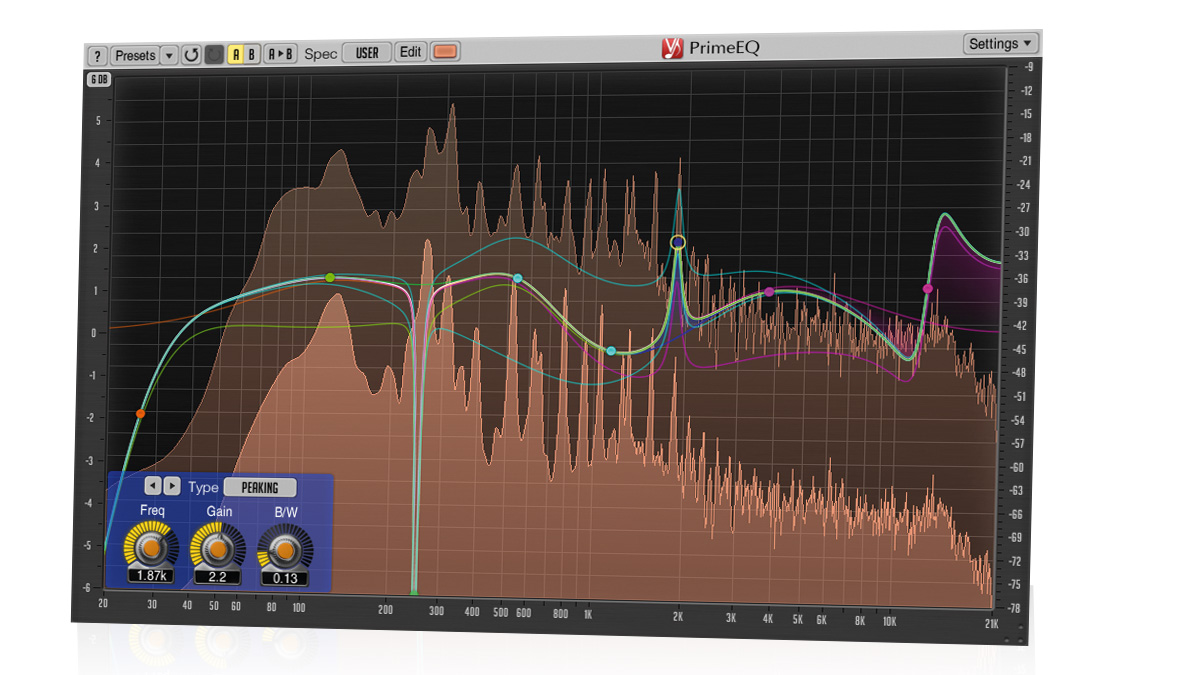MusicRadar Verdict
A brilliant bread-and-butter equaliser, PrimeEQ covers all frequency sculpting bases with incredible precision, unrivalled customisability and superb visualisation
Pros
- +
Slick, flexible interface Up to 32 bands. 13 filter options. Well-equipped analyser. Cheap!
Cons
- -
Meagre presets. No preconfigured default
MusicRadar's got your back
With a range of excellent task-orientated EQs already in its lineup, including the linear-phase CurveEQ and valve-flavoured HarmoniEQ, the lack of a general purpose parametric EQ in the Voxengo line-up has long been a point of note.
With PrimeEQ (VST/AU), the Russian developer aims to fill that gap, although in typical Voxengo style, it's rather more malleable than the average parametric.
Fully configurable, PrimeEQ offers up to 32 independent parametric bands, each with 13 filter shapes to choose from, including typical high and low shelves, high- and low-pass filters, and peaking curves, alongside less commonplace (but handy) notch and band-pass options.
Editing PrimeEQ's filters is done directly in the main display, with the resulting EQ curve and the frequency content of the signal visualised in the onboard spectrum analyser.
The plugin loads as a 'blank canvas' with just one inactive band that's activated by selecting a filter shape for it, either by clicking the node in the main display or opening the fold-up panel at the bottom. Most filter shapes include some form of bandwidth setting, once again accessed in the panel as well as by Cmd/Ctrl-dragging the node.
Adding more bands is a simple matter of double-clicking anywhere in the display, and double-clicking an existing node bypasses its band. Multiple band nodes can be lassoed to allow collective adjustment of frequency and gain, but not bypassing.
Overall, it's a simple, clean workflow, enabling you to effortlessly add bands as and when they're needed. Nonetheless, PrimeEQ would benefit from at least one preconfigured default setup with, say, six bands positioned at key frequencies.
Flexible friend
The gain range of PrimeEQ's display on the left-hand vertical axis can be scaled to cover anywhere from 3dB to 30dB, enabling you to tailor it to the task at hand, from mastering (where a few dB is enough) to frequency notching (where large cuts are required).
Further graphics-related preferences are found in the Settings page, including the option to show individual filter plots for every band in addition to the aggregate curve defined by the combined filters.
Another handy graphical feature is the mouse pointer, which reveals the frequency, gain and note pitch (including Cents) at the point at which it's placed in the display.
PrimeEQ is designed to be transparent, so what you see really is what you get/hear. The main peak and shelving filters are very versatile, with bandwidth settings allowing super-narrow peaks, shelving overshoot and, by combining bands, pretty much any curve shape you like.
Combining bands can also get you way beyond the 30dB of gain available to each one individually. In fact, with so much power on tap, it's a shame Voxengo hasn't opted to show it off in a decent set of presets (there are only six).
Although marketed as a run-of-the-mill parametric EQ, PrimeEQ is far from basic, epitomising the modern digital EQ.
PrimeEQ's wonderfully flexible, graphic-driven design and excellent visual feedback make it a joy to use, and the paucity of presets and lack of a meaningful default setup are its only failings.
Computer Music magazine is the world’s best selling publication dedicated solely to making great music with your Mac or PC computer. Each issue it brings its lucky readers the best in cutting-edge tutorials, need-to-know, expert software reviews and even all the tools you actually need to make great music today, courtesy of our legendary CM Plugin Suite.
“I was like ‘Wow, Coldplay were definitely listening to Radiohead and trying to make their version of it’": Porter Robinson says that he only recently discovered that Coldplay used to sound a bit like Radiohead
Why is tennis superstar Serena Williams being bombarded with microphones fired from confetti cannons? Allow us to explain…
Carlos Santana collapses and then cancels second show “out of an abundance of caution”











